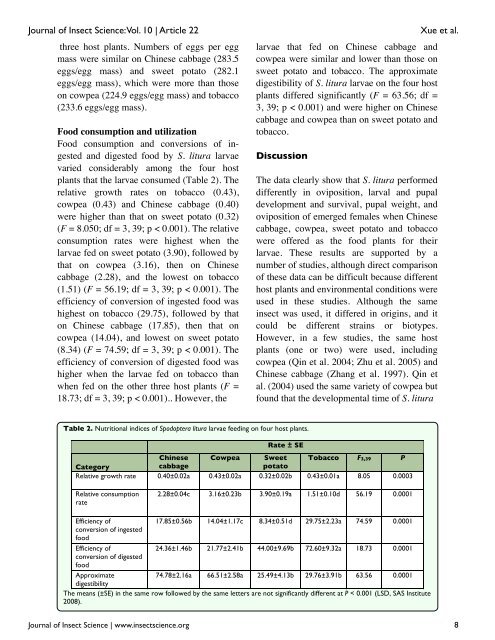Effects of four host plants on biology and food utilization - Journal of ...
Effects of four host plants on biology and food utilization - Journal of ...
Effects of four host plants on biology and food utilization - Journal of ...
You also want an ePaper? Increase the reach of your titles
YUMPU automatically turns print PDFs into web optimized ePapers that Google loves.
<strong>Journal</strong> <str<strong>on</strong>g>of</str<strong>on</strong>g> Insect Science: Vol. 10 | Article 22<br />
three <str<strong>on</strong>g>host</str<strong>on</strong>g> <str<strong>on</strong>g>plants</str<strong>on</strong>g>. Numbers <str<strong>on</strong>g>of</str<strong>on</strong>g> eggs per egg<br />
mass were similar <strong>on</strong> Chinese cabbage (283.5<br />
eggs/egg mass) <strong>and</strong> sweet potato (282.1<br />
eggs/egg mass), which were more than those<br />
<strong>on</strong> cowpea (224.9 eggs/egg mass) <strong>and</strong> tobacco<br />
(233.6 eggs/egg mass).<br />
Food c<strong>on</strong>sumpti<strong>on</strong> <strong>and</strong> utilizati<strong>on</strong><br />
Food c<strong>on</strong>sumpti<strong>on</strong> <strong>and</strong> c<strong>on</strong>versi<strong>on</strong>s <str<strong>on</strong>g>of</str<strong>on</strong>g> ingested<br />
<strong>and</strong> digested <strong>food</strong> by S. litura larvae<br />
varied c<strong>on</strong>siderably am<strong>on</strong>g the <str<strong>on</strong>g>four</str<strong>on</strong>g> <str<strong>on</strong>g>host</str<strong>on</strong>g><br />
<str<strong>on</strong>g>plants</str<strong>on</strong>g> that the larvae c<strong>on</strong>sumed (Table 2). The<br />
relative growth rates <strong>on</strong> tobacco (0.43),<br />
cowpea (0.43) <strong>and</strong> Chinese cabbage (0.40)<br />
were higher than that <strong>on</strong> sweet potato (0.32)<br />
(F = 8.050; df = 3, 39; p < 0.001). The relative<br />
c<strong>on</strong>sumpti<strong>on</strong> rates were highest when the<br />
larvae fed <strong>on</strong> sweet potato (3.90), followed by<br />
that <strong>on</strong> cowpea (3.16), then <strong>on</strong> Chinese<br />
cabbage (2.28), <strong>and</strong> the lowest <strong>on</strong> tobacco<br />
(1.51) (F = 56.19; df = 3, 39; p < 0.001). The<br />
efficiency <str<strong>on</strong>g>of</str<strong>on</strong>g> c<strong>on</strong>versi<strong>on</strong> <str<strong>on</strong>g>of</str<strong>on</strong>g> ingested <strong>food</strong> was<br />
highest <strong>on</strong> tobacco (29.75), followed by that<br />
<strong>on</strong> Chinese cabbage (17.85), then that <strong>on</strong><br />
cowpea (14.04), <strong>and</strong> lowest <strong>on</strong> sweet potato<br />
(8.34) (F = 74.59; df = 3, 39; p < 0.001). The<br />
efficiency <str<strong>on</strong>g>of</str<strong>on</strong>g> c<strong>on</strong>versi<strong>on</strong> <str<strong>on</strong>g>of</str<strong>on</strong>g> digested <strong>food</strong> was<br />
higher when the larvae fed <strong>on</strong> tobacco than<br />
when fed <strong>on</strong> the other three <str<strong>on</strong>g>host</str<strong>on</strong>g> <str<strong>on</strong>g>plants</str<strong>on</strong>g> (F =<br />
18.73; df = 3, 39; p < 0.001).. However, the<br />
larvae that fed <strong>on</strong> Chinese cabbage <strong>and</strong><br />
cowpea were similar <strong>and</strong> lower than those <strong>on</strong><br />
sweet potato <strong>and</strong> tobacco. The approximate<br />
digestibility <str<strong>on</strong>g>of</str<strong>on</strong>g> S. litura larvae <strong>on</strong> the <str<strong>on</strong>g>four</str<strong>on</strong>g> <str<strong>on</strong>g>host</str<strong>on</strong>g><br />
<str<strong>on</strong>g>plants</str<strong>on</strong>g> differed significantly (F = 63.56; df =<br />
3, 39; p < 0.001) <strong>and</strong> were higher <strong>on</strong> Chinese<br />
cabbage <strong>and</strong> cowpea than <strong>on</strong> sweet potato <strong>and</strong><br />
tobacco.<br />
Discussi<strong>on</strong><br />
The data clearly show that S. litura performed<br />
differently in ovipositi<strong>on</strong>, larval <strong>and</strong> pupal<br />
development <strong>and</strong> survival, pupal weight, <strong>and</strong><br />
ovipositi<strong>on</strong> <str<strong>on</strong>g>of</str<strong>on</strong>g> emerged females when Chinese<br />
cabbage, cowpea, sweet potato <strong>and</strong> tobacco<br />
were <str<strong>on</strong>g>of</str<strong>on</strong>g>fered as the <strong>food</strong> <str<strong>on</strong>g>plants</str<strong>on</strong>g> for their<br />
larvae. These results are supported by a<br />
number <str<strong>on</strong>g>of</str<strong>on</strong>g> studies, although direct comparis<strong>on</strong><br />
<str<strong>on</strong>g>of</str<strong>on</strong>g> these data can be difficult because different<br />
<str<strong>on</strong>g>host</str<strong>on</strong>g> <str<strong>on</strong>g>plants</str<strong>on</strong>g> <strong>and</strong> envir<strong>on</strong>mental c<strong>on</strong>diti<strong>on</strong>s were<br />
used in these studies. Although the same<br />
insect was used, it differed in origins, <strong>and</strong> it<br />
could be different strains or biotypes.<br />
However, in a few studies, the same <str<strong>on</strong>g>host</str<strong>on</strong>g><br />
<str<strong>on</strong>g>plants</str<strong>on</strong>g> (<strong>on</strong>e or two) were used, including<br />
cowpea (Qin et al. 2004; Zhu et al. 2005) <strong>and</strong><br />
Chinese cabbage (Zhang et al. 1997). Qin et<br />
al. (2004) used the same variety <str<strong>on</strong>g>of</str<strong>on</strong>g> cowpea but<br />
found that the developmental time <str<strong>on</strong>g>of</str<strong>on</strong>g> S. litura<br />
Xue et al.<br />
Table 2. Nutriti<strong>on</strong>al indices <str<strong>on</strong>g>of</str<strong>on</strong>g> Spodoptera litura larvae feeding <strong>on</strong> <str<strong>on</strong>g>four</str<strong>on</strong>g> <str<strong>on</strong>g>host</str<strong>on</strong>g> <str<strong>on</strong>g>plants</str<strong>on</strong>g>.<br />
Rate ± SE<br />
Chinese Cowpea Sweet Tobacco F3,39 P<br />
Category<br />
cabbage<br />
potato<br />
Relative growth rate 0.40±0.02a 0.43±0.02a 0.32±0.02b 0.43±0.01a 8.05 0.0003<br />
Relative c<strong>on</strong>sumpti<strong>on</strong><br />
rate<br />
2.28±0.04c 3.16±0.23b 3.90±0.19a 1.51±0.10d 56.19 0.0001<br />
Efficiency <str<strong>on</strong>g>of</str<strong>on</strong>g><br />
c<strong>on</strong>versi<strong>on</strong> <str<strong>on</strong>g>of</str<strong>on</strong>g> ingested<br />
<strong>food</strong><br />
17.85±0.56b 14.04±1.17c 8.34±0.51d 29.75±2.23a 74.59 0.0001<br />
Efficiency <str<strong>on</strong>g>of</str<strong>on</strong>g><br />
24.36±1.46b 21.77±2.41b 44.00±9.69b 72.60±9.32a 18.73 0.0001<br />
c<strong>on</strong>versi<strong>on</strong> <str<strong>on</strong>g>of</str<strong>on</strong>g> digested<br />
<strong>food</strong><br />
Approximate<br />
74.78±2.16a 66.51±2.58a 25.49±4.13b 29.76±3.91b 63.56 0.0001<br />
digestibility<br />
The means (±SE) in the same row followed by the same letters are not significantly different at P < 0.001 (LSD, SAS Institute<br />
2008).<br />
<strong>Journal</strong> <str<strong>on</strong>g>of</str<strong>on</strong>g> Insect Science | www.insectscience.org 8

















